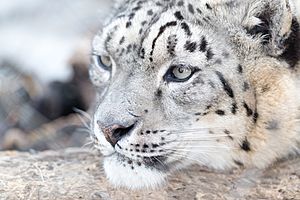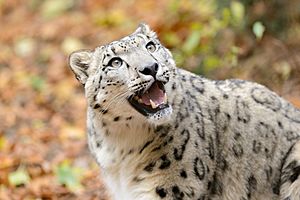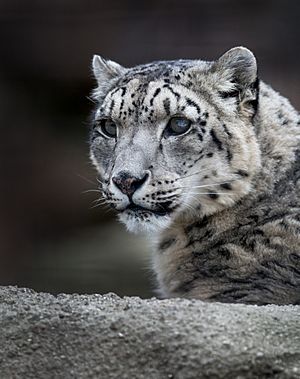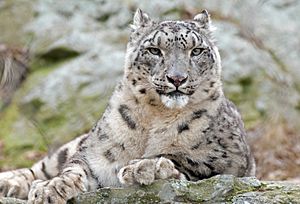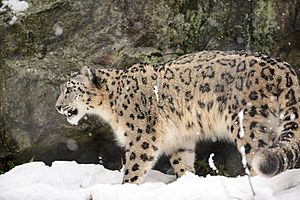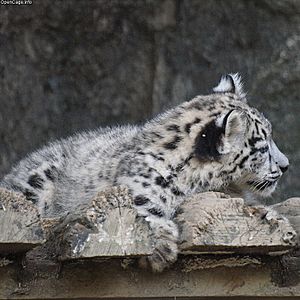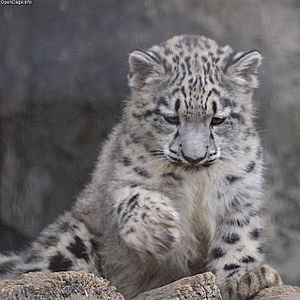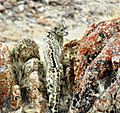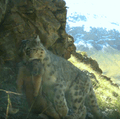Snow leopard facts for kids
Quick facts for kids Snow leopard |
|
|---|---|
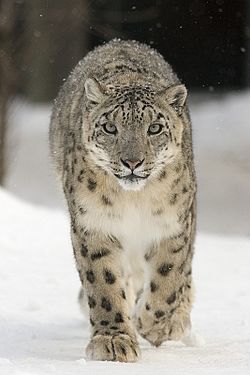 |
|
| Conservation status | |
| Scientific classification | |
| Kingdom: | |
| Class: | |
| Order: | |
| Family: | |
| Subfamily: | |
| Genus: | |
| Species: |
P. uncia
|
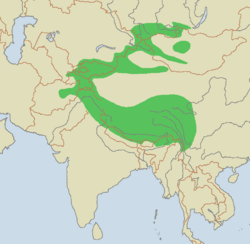 |
|
| Range map | |
The snow leopard or ounce (Panthera uncia) is a large cat that lives in the mountains of Central and South Asia. These amazing cats are known for their beautiful fur and their ability to survive in very cold places.
Sadly, snow leopards are listed as Vulnerable on the IUCN Red List of Threatened Species. This means their numbers are getting low. In 2016, there were only about 4,678 to 8,745 adult snow leopards left in the wild.
Contents
What Snow Leopards Look Like
Snow leopards usually weigh between 22 and 55 kilograms (48 to 121 pounds). They have soft, thick fur that is grey and white. Their fur has dark spots and patterns called rosettes. Their long tails have stripes.
Their fur is super long and thick. This helps them stay warm in the freezing mountain weather. Their feet are also big and furry. This helps them walk easily on deep snow.
A snow leopard's tail is very long, about 80 to 105 cm (31 to 41 inches). They use their long tails to help them balance when climbing rocky mountains. They also wrap their tails around themselves like a blanket to keep warm.
How Snow Leopards Behave
Snow leopards are mostly alone, except for mothers with their cubs. Mothers raise their cubs in mountain dens for a long time. Male snow leopards need a large area, about 80 square miles, for their home. Females need a bit less, around 48 square miles.
Like other cats, snow leopards use scent marks to show where their territory is. They also mark common paths they use. They often scrape the ground with their back feet. Then they leave their urine or scat there. They might also spray urine onto rocks.
How Snow Leopards Hunt
Snow leopards hunt by themselves. They do not hunt in groups like lions.
These cats are very good at blending in with their surroundings. They are most active at dawn and dusk. They quietly sneak up on medium-sized animals. Their favorite foods include Ibex, bharal (mountain sheep), and wild goats.
Snow leopards like to ambush their prey from above. They use the rocky land to hide as they get close. They kill their prey with a bite to the neck. Then they might drag the animal to a safe spot to eat. A snow leopard needs to eat about 20 to 30 adult sheep (bharal) in a year.
What Snow Leopards Eat
Their main foods are wild sheep and goats. They also eat smaller animals like pikas, hares, and game birds. In the summer, they mostly eat smaller prey, such as marmots. At other times, they might eat wild boars, gazelles, markhor, and deer. They sneak up on their prey. They usually start their attack when they are 6 to 15 meters (20 to 50 feet) away.
A snow leopard's wide paws act like snowshoes. They help the cat grip stone, snow, and ice when chasing prey. They are best at running on hard, icy snow crusts. Their prey often breaks through the crust and gets stuck in the soft snow below.
Where Snow Leopards Live
In summer, snow leopards usually live high up in the mountains. They are found above the tree line in rocky areas. They live at altitudes from 2,700 to 6,000 meters (8,858 to 19,685 feet). In winter, they come down into the forests. They can be found at altitudes around 1,200 to 2,000 meters (3,937 to 6,562 feet). Snow leopards prefer rocky land. They often use paths made by other animals.
Snow leopards live in the tall mountains of China and Central Asia. They are especially found throughout the Himalayas. They usually have a hunting area of about 260 square kilometers (100 square miles). This is because there are not many prey animals in their harsh mountain home.
Snow Leopard Life Cycle
Snow leopards can have babies when they are two to three years old. They usually live for 15 to 18 years in the wild. In zoos, they can live up to 25 years. Cubs are born between April and June.
The mother gives birth in a rocky den or crack. She lines it with fur she sheds from her belly. A mother can have one to five cubs, but usually has two. The cubs are born blind and helpless. But they already have a thick coat of fur. Their eyes open after about seven days. The cubs can walk at five weeks old. They stop drinking milk by 10 weeks. When they are born, they have black spots. These spots turn into rosettes as they grow older.
The cubs leave the den when they are about two to four months old. They stay with their mother until they are about 18 to 22 months old. After that, they go off on their own. They can travel long distances to find new hunting grounds.
Dangers to Snow Leopards
One big danger to snow leopards is poaching. This means people hunt them illegally for their skins. Greenhouse gas emissions are also a problem. They will likely cause the treeline in the Himalayas to move higher. This will make the alpine zone smaller. This could reduce the snow leopard's home by about 30%.
Sometimes, snow leopards hunt farm animals like livestock. This causes problems between humans and snow leopards. Losing their natural prey because of too many farm animals eating their food, poaching, and protecting farm animals are the main reasons why snow leopard numbers are going down.
Interesting Facts About the Snow Leopard
- The snow leopard has the longest tail of any cat.
- It can hunt animals three times its own size!
- Snow leopards can travel easily in snow up to 85 cm (33 inches) deep.
- They can survive by eating just one sheep for two weeks.
- In 2008, there were about 600 snow leopards living in zoos around the world.
Protecting Snow Leopards
The snow leopard is listed in CITES Appendix I. This is an international agreement that protects endangered animals. It has been protected since 1985 by the Convention on the Conservation of Migratory Species of Wild Animals.
In India, the snow leopard has the highest level of protection. This is under the Wildlife Protection Act, 1972. Hunting them can lead to 3 to 7 years in prison. In Nepal, they have been protected since 1973. Poaching or trading them can result in 5 to 15 years in prison and a fine.
In China, snow leopards have been protected by law since 1989. Hunting or trading snow leopards or their body parts is a criminal offense. It can lead to property being taken away, a fine, and at least 10 years in prison.
Snow leopards live in these protected areas:
- In Kazakhstan: Aksu-Zhabagly Nature Reserve
- In Russia: Katun Nature Reserve, Sayano-Shushenski Nature Reserve
- In Kyrgyzstan: Sarychat-Ertash State Nature Reserve, Sary-Chelek Nature Reserve, Besh-Tash State Nature National Park, Kyrgyz-Ata National Park, Karakol National Park, Chychkan Wildlife Refuge
- In Uzbekistan: Chatkalskiy State Nature Reserve, Zaamin National Park, Ugam-Chatkal National Park, Hissar National Reserve
- In Tajikistan: Pamir National Park
- In Mongolia: Altai Tavan Bogd National Park, Tsambagarav Uul National Park, Har Us Nuur National Park and Gobi Gurvansaikhan National Park
- In China: Chang Tang Nature Reserve, Qomolangma National Nature Preserve and Sanjiangyuan National Nature Reserve on the Tibetan Plateau, Tomur National Conservation Zone in the western Tianshan Mountains, Qilianshan National Nature Reserve in the Qilian Mountains
- In Pakistan: Chitral National Park in the Khyber-Pakhtunkhwa region, Central Karakoram National Park and Khunjerab National Park in Gilgit-Baltistan, Deosai National Park, Naltar Wildlife Sanctuary, Baltistan Wildlife Sanctuary and several smaller protected areas
- In India: Hemis National Park, Kishtwar National Park, Dachigam National Park, Gulmarg Wildlife Sanctuary, Hirpora Wildlife Sanctuary, Rangdum Wildlife Reserve, Overa-Aru, Kanji, Gya-Miru and Baltal-Thajwas Wildlife Sanctuaries in Ladakh, Jammu and Kashmir; Pin Valley National Park, Great Himalayan National Park, Rupi-Bhaba Wildlife Sanctuary, Sechu Tuan Nala Wildlife Sanctuary and Kibber Wildlife Sanctuary in Himachal Pradesh; Nanda Devi National Park, Gangotri National Park and Valley of Flowers National Park in Uttarakhand; Khangchendzonga National Park and Dibang Wildlife Sanctuary in the Eastern Himalayas
- In Nepal: Api Nampa Conservation Area, Dhorpatan Hunting Reserve, Shey Phoksundo National Park, Annapurna Conservation Area, Manaslu Conservation Area, Langtang National Park, Sagarmatha National Park, Makalu Barun National Park and Kanchenjunga Conservation Area
- In Bhutan: Bumdeling Wildlife Sanctuary, Jigme Dorji National Park and Wangchuck Centennial National Park.
At the end of 2020, 35 cameras were set up near Almaty, Kazakhstan. People hoped to film snow leopards. In November 2021, the Russian World Wildlife Fund (WWF) said that snow leopards were seen 65 times on these cameras. This was in the Trans-Ili Alatau mountains since the cameras were put there.
| Country | Year | Number of Snow Leopards |
|---|---|---|
| Afghanistan | 2016 | 50–200 |
| Bhutan | 2016 | 79–112 |
| China | 2016 | 4,500 |
| India | 2016 | 516–524 |
| Kazakhstan | 2016 | 100–120 |
| Kyrgyzstan | 2016 | 300–400 |
| Mongolia | 2016 | 1,000 |
| Nepal | 2016 | 301–400 |
| Pakistan | 2016 | 250-420 |
| Russia | 2016 | 70–90 |
| Tajikistan | 2016 | 250–280 |
| Uzbekistan | 2016 | 30–120 |
How Snow Leopards Are Classified
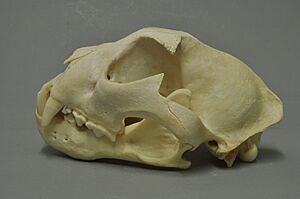
Scientists group living things to understand them better. Here's how the snow leopard fits in:
- Kingdom: Animalia (This means they are animals)
- Phylum: Chordata (Meaning they have a backbone)
- Class: Mammalia (This means they are mammals, warm-blooded and have fur)
- Order: Carnivora (Meaning they eat meat)
- Family: Felidae (They belong to the cat family)
- Genus: Panthera (This is the group of big cats like lions and tigers)
- Species: uncia (This is their specific name)
Their scientific name is Panthera uncia. Sometimes, you might also see their scientific name as Uncia uncia. This is because some scientists used to think they were different enough to be in their own group. But newer studies show they are closely related to other big cats in the Panthera group, especially tigers!
Images for kids
-
Snow leopard at Hemis National Park, India
-
Snow leopard with Himalayan marmot, Kyrgyzstan
-
Snow leopard cubs at the Cat Survival Trust, Welwyn, UK
See Also
 In Spanish: Leopardo de las nieves para niños
In Spanish: Leopardo de las nieves para niños



